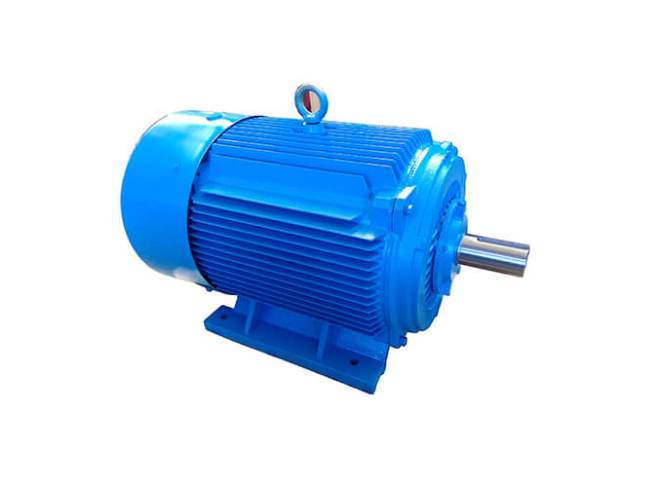Synchronous vs. Induction Motors - What Do You Want to Know?
The first step in finding any motor is to determine its power supply; is it powered by AC, or DC? This will divide the options into two main categories, AC Motors and DC motors, and will eliminate any motors that do not match your electrical supply. However, both categories still contain many kinds of machines, so this article will help further differentiate the AC motor category. AC motors can be divided into synchronous and induction motors, and this article will provide a brief description of both, as well as a comparison of their operating characteristics and applications.
Induction motors
Induction motors are considered to be one of, if not the most, used AC motors in industry today. They were one of the first motors invented and therefore have had enough time to be optimized for working in many applications. They have a relatively simple structure, consisting of an external stator and an internal rotor that interact through electromagnetic induction effects to produce mechanical rotation.
Specific types of induction motors achieve this rotation in different ways, but in general, the goal of an induction motor is to pass alternating current through a coil in the stator to produce a magnetic field, and the frequency of oscillation of the AC power supply will cause this field to rotate. This rotating magnetic field will then induce an opposite magnetic field in the rotor - a free-moving armature attached to the output shaft - and cause useful rotation.Get a free quotation.

Synchronous Motors
These motors are also called asynchronous motors because the frequency of their AC current does not directly match the number of rotations of the output shaft. This phenomenon is called "slip" and it occurs because the rotor is always playing a magnetic game of "catch-up" with the RMF. The presence of slip means that induction motors are difficult to time accurately. As mentioned earlier, these motors can be found in household appliances, electric cars, and even large mechanized industrial equipment because they come in hundreds of speeds, torques, voltages, sizes, and forms.
Synchronous motors
Synchronous motors cover the bases that induction motors do not, namely their "asynchronous" nature. Synchronous Motors match the output rotational frequency to the input AC frequency, allowing designers to use these motors for precision timing applications such as clocks, rolling mills, record players, etc. They accomplish this feat by connecting the magnetic poles of the stator and rotor so that the stator RMF will rotate the rotor at a precisely synchronized speed.
Synchronous motors are not inherently self-starting-that is, these motors typically require a motor starter to excite their rotors to full speed. These starters are not typically used for induction motors, as these motors can be started from standstill and do not require an initial "kick". Also, although they are synchronous, the speed of a synchronous motor is difficult to change and requires an AC motor controller to allow the designer to adjust the motor speed. Synchronous motors, while typically more expensive than induction motors, are more efficient and are the best choice for crushers, mills, grinders and other low-speed, high-power applications.

The complexity of induction motors is the biggest advantage they have over synchronous designs. They are very simple to manufacture, operate and maintain, which is why induction motors are so much cheaper than synchronous motors. Conversely, implementing synchronous motors requires more complex rotors, which are more difficult to manufacture/maintain, and additional circuitry needs to be purchased and installed to make these motors operate efficiently.
As mentioned earlier, induction motors are usually self-starting, while synchronous motors are not. This means that induction motors require fewer peripherals to operate efficiently, thus reducing cost and complexity.
Power density is the amount of power produced per unit of motor volume. Synchronous motors typically have a higher power density than induction motors of the same size, which allows them to deliver more power in a smaller volume. This is useful for size-constrained applications and is the reason for choosing synchronous motors over induction motors.
In some cases, synchronous motors can achieve efficiencies of > 90% and are often more energy efficient than induction motors. Efficiency depends on the specific motor type and size, but synchronous motors have no slip, which means less energy is lost in the conversion between electrical and mechanical energy.
Finally, a common theme between synchronous and induction motors is their price separation. For the reasons explained earlier, synchronous motors cost more to produce, implement, maintain and repair than induction motors. However, it can be assumed that their energy savings and power factor correction capabilities can compensate for their higher initial costs. Whether or not this holds true will ultimately depend on the specific application at hand, but should be considered, as the total life cycle cost should always be kept to a minimum in any project.
Related Products
Electric motor
Induction motor
large synchronous motor
OVERVIEW
This article provides a brief comparison between AC Induction Motors and synchronous motors, please feel free to contact us if you would like to.


评论
发表评论